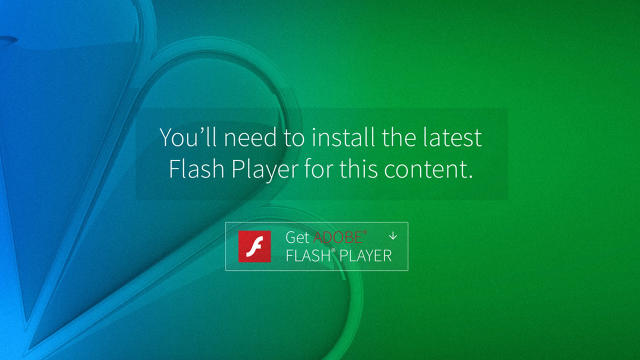The Agonizingly sluggish Decline Of Adobe Flash participant
despite business-extensive requires Flash’s loss of life, numerous main web pages still use the growing older browser plugin. they usually won’t explain why.
August 18, 2015
This story on Adobe Flash used to be speculated to end up just a little another way.
the speculation was to talk with one of the vital greatest web pages still the usage of Adobe’s browser plugin, which has fallen out of favor within tech circles for its constant safety concerns and thirst for machine tools. maybe they could provide an explanation for why Flash is still important, providing a counterpoint to the resounding calls to end its existence.
as a substitute, lots of the vendors of Flash-reliant web pages I contacted didn’t want to discuss at all. HBO, NBC, CBS, Zynga, King, Showtime, Pandora, and Spotify—all of which require Flash on their pc sites—declined to remark. major League Baseball, Slacker Radio, Hulu, and the BBC didn’t reply to inquiries.
My tried survey wasn’t a total failure. among the web sites that were prepared to speak, all of them are planning to maneuver beyond Flash player within a yr or so. however even supposing the generation of Flash is winding down, it’s going to be a while unless it can be totally wiped from the net.

What’s fallacious With Flash
if you need an explainer on why Adobe Flash player must go, the perfect resource continues to be a 5-yr-previous essay by means of Steve Jobs. at the time, Jobs was purely explaining why Flash would never convey up on iPhones and iPads. but lately so much of the 1,seven hundred-phrase missive serves as takedown of the expertise as a complete, making use of just as well to laptops and laptop PCs.
security, for example, is still an enormous concern, with new exploits taking drugs regularly. in one recent example, hackers have been even ready to damage during the sandboxing that’s meant to minimize vulnerabilities in Google Chrome. Flash is also a infamous useful resource hog, which is a problem as laptops become thinner, lighter, and extra reliant on power efficiency for lengthy battery life.
All of this has introduced calls to kill Flash to a fever pitch, not just on mobile devices, however all over the place. Alex Stamos, facebook’s chief safety officer, wrote on Twitter ultimate month that Adobe will have to set a firm finish-of-life date for the plugin. in the meantime, an “Occupy Flash” website online has popped up, urging users to uninstall Flash and asking builders to make use of different technologies comparable to HTML5.

at the moment, it’s more uncomplicated to browse the web Flash-free. Many sites have moved away from Flash for animations and snap shots, and web browsers’ popular adoption of digital-rights management for HTML5 has allowed major video and track web sites to depart Flash player behind. Netflix and YouTube both work with out Flash, as do Google Play music and Rdio. Amazon additionally started rolling out an HTML5 participant final month.
still, a mass exodus or firm cutoff for Flash would be more uncomplicated mentioned than achieved.

transferring beyond Flash
regardless of the pressure from tech circles, the websites I spoke with mentioned they simply weren’t ready to begin shifting away from Flash except lately, when higher know-how turn into on hand. And even now, it’s going to take time for them to complete building the important instruments.
“at the beginning, Flash used to be vital to solve a couple issues,” says Adam Denenberg, chief technical officer for streaming tune carrier iHeartRadio. “Streaming was tough, especially for reside stations, and there have been no real http-supported streaming protocols that offered the pliability of what was once required a couple of years back.”
while Denenberg says there’s no longer much purpose to deploy a brand new Flash-primarily based streaming solution at this level, iHeartRadio still needs time to make the transition from its present platform. the company already uses HTTP live Streaming for its own on-line radio stations, but some of its 0.33-party broadcasters still rely on Flash. An internal mission is beneath way to convert those sources to HTTP are living Streaming on the fly, and the company additionally has to complete rebuilding its own media player in HTML5. All informed, iHeartRadio hopes to be completely Flash-free via the top of the 12 months.
Autodesk, meanwhile, is wading in slowly with an HTML5- and WebGL-based version of its Pixlr on-line picture enhancing instruments. A beta version of Pixlr categorical is coming later this summer.

“in the event you look again two years in the past, i think we definitely had a more difficult time, since the technology wasn’t as mature as nowadays,” says Thomas Heermann, director of digital arts for Autodesk’s shopper trade, “there have been limitations on HTML5, but now you don’t see any problems anymore.”
nevertheless, Pixlr has no plans to discontinue the Flash versions of its modifying tools. That’s because a great chunk of its users are working older browsers in legacy running systems that don’t make stronger HTML5 and WebGL.
That speaks to a larger issue, which is that many customers out of doors of the tech bubble don’t in particular care whether they’re the usage of Flash or not. Bjørn Rustberggaard, cofounder of on-line video modifying software WeVideo, says he hasn’t considered various requests from users to offer a Flash-free version. Most of them simply want the app to work regardless of what browser they’re the use of.
“If it is a mother making tales about her youngsters, or if it is a pupil enhancing a historical past mission, or it can be a professional journalist the use of it to interrupt the news, it in point of fact does not matter if the trade is getting rid of Flash, as long as it works for them,” Rustberggaard says.
however, WeVideo has been experimenting with an HTML5 version for just a few years now, and objectives to offer it to users early subsequent yr. once more, the corporate has been ready for certain APIs and low-degree audio and video beef up across all major browsers. “For us, it is basically a timing problem,” Rustberggaard says. “When will HTML be just right sufficient so it just works?”

slow, constant Slip
in spite of everything, web pages gained’t actually want the motivation to get rid of Flash within the form of a troublesome cutoff date. As net know-how permits for alternatives, market forces will indirectly demand that more internet sites make the change of their very own volition.
iHeartRadio, for instance, desires its radio stations to work in any net browser, including cell browsers that do not enhance Flash, which is a giant for the reason that the corporate is pushing so arduous now for an HTML5 player and HTTP live Streaming. “while you consider the increase of visitors heading to cell, an HTML5-supported participant is even more vital, and in a roundabout way required,” Denenberg says.
the fact that Adobe has essentially stopped seeking to do the rest new and innovative with Flash can be prompting builders to move on. taking a look forward, Autodesk’s Heermann expects that Pixlr’s HTML5 and WebGL versions will embody new features, whereas supporting structures that aren’t as Flash-pleasant.
“Flash is maintenance mode,” Heermann says. “Adobe’s nonetheless fixing bugs and security issues, and it’s a reliable platform, however with HTML5 and WebGL, we have a chance to even go beyond what Flash is as of late.”
Even the flexibility to attract developer talent generally is a legal responsibility if internet sites keep on with Flash. That’s a big motive WeVideo is looking to switch, despite an absence of requests from users. “developers are captivated with know-how, and no person wants to spend a lot of hours sustaining and creating one thing that they suspect is dead,” Rustberggaard says. “so as to inspire your tech group, you really have to show that you are ahead of the curve in relation to the usage of know-how.”
these forces appear to be working in more than just anecdotes. five years in the past, 28.9% of web pages used Flash come what may, in keeping with Matthias Gelbmann, managing director at internet know-how metrics firm W3Techs. As of August, Flash usage had fallen to 10.3%.
but higher web sites have an extended approach to go. Flash persists on 15.6% of the top 1,000 websites, Gelbmann says. That’s actually the opposite situation when compared to a few years ago, when Flash was used on 22.2% of the most important websites, and 25.6% of websites general.
In other words, the greater the web page, the slower it’s to maneuver away from Flash—and, most likely, the more ashamed it is to confess it.
(88)














